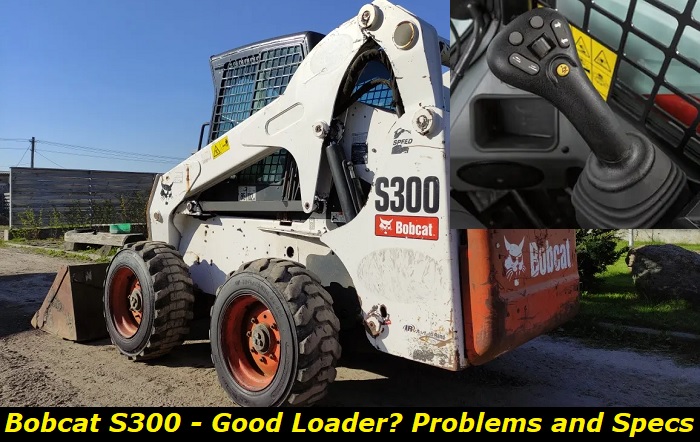Bobcat S300: Problems, Durability, Repairs
The Bobcat S300 skid-steer loader operates at the highest level of performance. This is thanks to the excellent capacity of its vertical lift path, increased weight for better stability, and more horsepower to get a lot of jobs done. It can operate with heavy loads and can handle various high flow-attachments.
In this article, we will assess the elements that are crucial in the evaluation of the quality of the Bobcat S300. Here, we will take a look at its durability as well as the known problems that plague its users. In the end, we hope that the information provided here will give you a clearer idea of what to expect from this product.

Durability of the Bobcat S300
A well-oiled Bobcat S300 can get you up to 8,000 operating hours without running into major problems. This is pretty much above the average of 5,000 hours possessed by its competitors. In a well-kept environment and operating conditions matched with periodic maintenance, some say that you could even stretch the numbers by 10,000 hours.
On the other hand, some unfortunate operators have claimed that some problems with its crucial parts become evident around the 4,000-hour frame. The parts that tend to take a hit first are those in its hydraulic system such as its motor, which is included in the discussion in the succeeding section.
Most Common Issues Found in the Bobcat S300 Skid Steer Loader
Carrying the Bobcat brand name means the S300 is a versatile and resilient piece of heavy equipment. As shown in the previous section, it is built to last a long time but that does not mean that it does not have its own kryptonite along the way.
Some flaws in its overall design, regular wear and tear, bad operating habits, lack of maintenance, and other factors mostly lead to these common problems found in this product:
1. Overheating Muffler System
An overheating muffler on a Bobcat S300 skid steer loader is often caused by a leaky or stuck exhaust valve. The symptoms of this problem include excessive heat and smoke coming from the muffler, as well as increased engine noise due to air entering through the valve. This issue can be caused by either a faulty gasket, clogged exhaust valve, deteriorated manifold gaskets, too much oil in the crankcase, or an obstruction in the exhaust pipe.
In order to diagnose and repair this issue, you will need to start by checking any visible signs of leaks around the valve and manifold using a flashlight if needed. If you detect any leaking gaskets at these points, they must be replaced before the problem can be solved.
You will also need to check the valve itself for any clogs or obstructions, then use the appropriate cleaning tools to remove them. Another potential source of the issue is too much oil in the crankcase, which can be quickly diagnosed with a dipstick test. If there is too much oil present, it must be drained until the correct amount is reached.
If none of these solutions resolve your problem, you may need to replace some parts to fix it. The parts most likely to fail and require replacement are the gasket, manifold gaskets, exhaust valve, and/or exhaust pipe. Replacing these parts should help restore normal functionality and prevent further overheating issues with your Bobcat.
2. Quick Wear of the Filters
As a result of the abovementioned problem with the exhaust valve, the filters of the Bobcat S300 can also be prone to premature wear. Symptoms of this problem include a reduction in engine power, black smoke coming from the exhaust pipe, and a decrease in fuel economy.
The primary cause of this issue is usually an obstructed air filter due to clogged or worn-out parts. To diagnose and repair it, you will need to inspect the air filter housing and look for any signs of wear or damage that might be hindering its normal operation. If there is any visible damage to the filter itself, it should be replaced as soon as possible. Additionally, any debris such as leaves, dirt, or dust must also be cleaned out of the air intake system.
If these solutions do not resolve your issue, then you may need to replace some other components of your Bobcat S300's air intake system. The commonly replaced parts include the air filter, air filter housing, and/or air intake hose.
Replacing these parts should help restore normal performance to your Bobcat and prevent further problems related to the quick wear of the filters. It is also important to regularly maintain and clean your Bobcat's filters to ensure the vehicle's optimal performance and prevent the contamination of its critical parts from outside elements.
Keeping an eye out for any signs of wear or damage will also help you keep your Bobcat running smoothly and reliably for many years to come.
3. Hydraulic Drive Motor Failure
The hydraulic drive motor of the Bobcat 300 is a vital component in its operations, as it helps to provide power and motion for the various attachments. When something goes wrong with this component, it can mean a delay in work or even complete shutdowns.
To prevent this from happening, it is important to be aware of the symptoms of a failing hydraulic drive motor so that any necessary repairs can be done quickly and efficiently.
One key symptom of a failing hydraulic drive motor is an increase in engine noise or vibrations. This could indicate an issue with the valves not closing properly, leading to greater pressure on the engine and increased noise levels.
Another symptom could include sluggishness when operating heavy attachments such as a bucket, a snowblower, or a plow blade as well as a decrease in the overall power and performance of the vehicle.
The most common causes of a failing hydraulic drive motor are worn or damaged parts, such as seals, bearings, and valves. These parts can wear out over time due to constant use and often require replacements for the motor to operate properly again.
In addition to these worn-out components, debris or other foreign objects can get stuck in the valve ports which will prevent them from closing properly and block the flow of fluid that is necessary for proper operation. If either of these types of problems arises, they should be addressed immediately before more serious damage occurs.
When it comes to replacing any parts on the hydraulic drive motor, some specific parts tend to fail more often than others. For instance, the hydraulic pump and motor shaft assemblies are two of the most commonly replaced components on these machines. Other parts such as filters, tubes, hoses, and seals should also be inspected regularly for signs of wear or damage.
By making sure to inspect all of these parts regularly, it can go a long way towards avoiding breakdowns that could potentially bring work to a halt. To ensure the optimal performance of the hydraulic drive motor on the Bobcat 300 skid steer, it is important to make sure that any worn-out or damaged components are addressed quickly and properly with replacements.
Regular inspections can help catch any potential issues before they become more serious problems that lead to costly repairs in the future.
4. Damaged Glow Plugs
To promote effective fuel combustion in a diesel engine, a glow plug is a heating element that warms up incoming fuel and air. Your engine is started by fuel combustion, allowing you to move. Damaged glow plugs in the Bobcat S300 can cause a variety of symptoms, including hard starting, rough running or stalling after start-up, and excessive smoke.
Hard starting may be caused by insufficient heat generated by the glow plug before starting. If this is the case, the engine will often struggle to turn over and lack sufficient power to start.
Rough running or stalling after start-up might occur if the glow plugs are not providing enough heat due to being damaged or worn out. If this is the problem, there may be an intermittent misfire from one or more cylinders as the engine struggles to run smoothly on cold start-ups.
Excessive smoke could indicate that unburned fuel is entering into a cylinder when the glow plug isn't providing enough heat to ignite the fuel during start-up. This is usually caused by a worn-out or damaged glow plug.
The best solution for these issues is to replace the glow plugs with new ones. However, it may be necessary to carry out further checks to identify the exact cause of the problem. This could include carrying out tests on the glow plug wiring and checking the fuel pressure and volume to make sure they are within recommended parameters.
Additionally, it may be necessary to replace other components such as injectors or fuel filters if these are found to be causing the issue. In some cases, thorough cleaning of the engine's combustion chambers may also be necessary to restore the engine's performance. If all of these steps are taken and the problem persists, it may be necessary to take the vehicle to a professional for further diagnosis.
Conclusion
Overall, the Bobcat S300 is a tough skid steer loader. Its promised 8,000 to 10,000 operating hours definitely sounds well when converted to productivity. However, these numbers are only possible if you keep watch of its important parts through regular maintenance and taking care of the problems before they trigger more complicated issues.
Therefore, if you ever run into the problems shown here or others not mentioned here, be sure to get your vehicle transported to your trusted mechanic or Bobcat service center right away.

Add comment